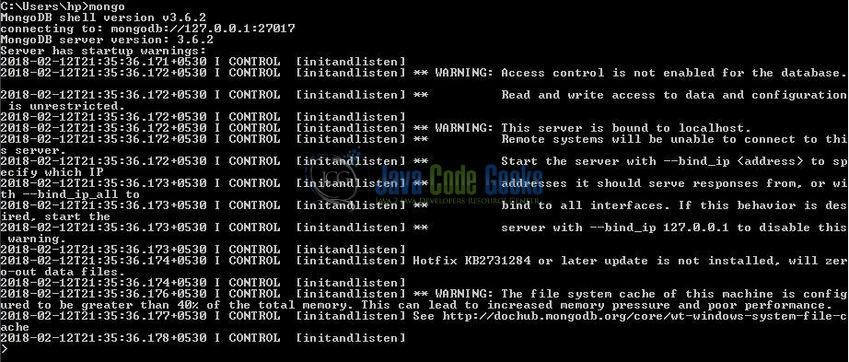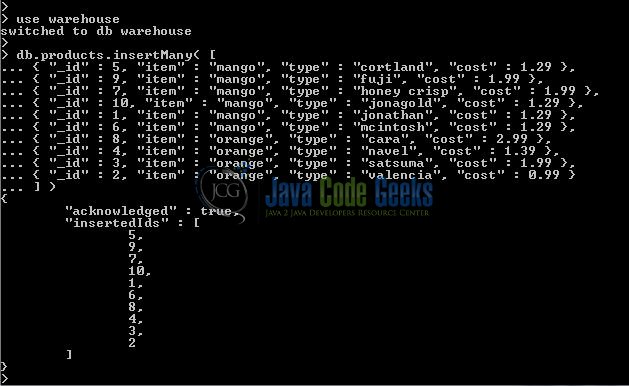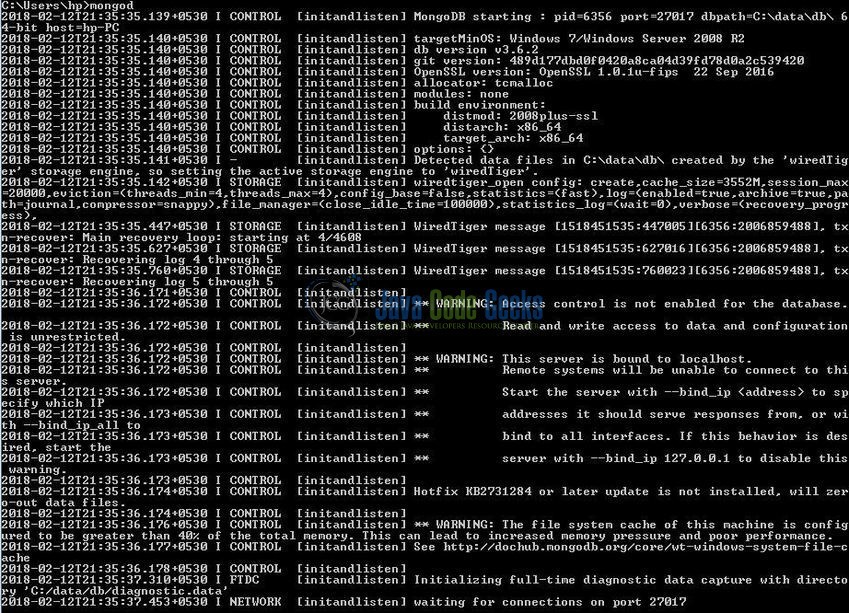MongoDB readPref() Example
Hello readers, in this tutorial, we will see the readPref() method available in the Mongo database.
1. Introduction
If you have installed the MongoDB application (version 3.6) on Windows or Ubuntu operating system and you wish to learn the readPref() method then follow the below steps. It is very simple, but before moving further let’s take a look at the Mongo database and its characteristics.
1.1 What is MongoDB?
- MongoDB is a high-performance NoSQL database where each database has collections which in turn has documents. Each document has a different number of fields, size, content, and is stored in a JSON-like format (i.e. Binary JSON (BSN))
- The documents in MongoDB doesn’t need to have a schema defined beforehand. Instead, the fields (i.e. records) can be created on the go
- Data model available within the MongoDB allows developers to represent the hierarchical relationships, store arrays, and other more complex structures easily
- This NoSQL solution often comes with embedding, auto-sharding, and onboard replication for better scalability and high availability
1.1.1 Why MongoDB?
- As a NoSQL type database, MongoDB stores the data in the form of a document. Thus, MongoDB offers more flexibility
- This database supports search by field-name, range queries, and the regular expressions. It often provides queries to return the particular fields inside the documents
- MongoDB offers indexes to improve the search performance within the NoSQL database
- To offer horizontal scalability, MongoDB uses sharding by splitting the data across the many MongoDB occurrences
- Replication: MongoDB can give high availability with the replica sets
1.2 What is a Cursor in MongoDB?
In Mongo world, a cursor is an object that allows developers to iterate through the documents of a Mongo collection. The behavior of cursor allows an automatic iteration across the results of the query; however, developers can explicitly go through the items returned in the cursor object. The below diagram lists 4 documents where the Mongo cursor will point to the first document and then iterate through all the other documents of a collection.

1.2.1 Why Cursor in MongoDB?
Cursor offers:
- A true snapshot of a system i.e. it returns the data in batches and increases the database performance
- It saves system memory by allowing batch inserts and updates
- Intelligibility and Clarity on the ad-hoc and complex queries of the sequential nature having large result sets and low consistency requirements
- Openness to work on small batches of data as developers don’t need to wait for the processing and download of the complete record-set
2. MongoDB readPref() Example
In this tutorial, we will learn how to handle the cursor.readPref() method provided by the Mongo database.
2.1 readPref() method in the Mongo database
In the Mongo universe, the readPref() method specifies a read preference for a cursor object to control how the client direct queries to the member of the replica set. The cursor.readPref() method has the following prototype form:
Mongo database ‘readPref()’ Syntax
> db.collection_name.find(<query_string>).readPref(<mode>, <tagSet>)
Where:
- The
query_stringin thefind()method is an optional input argument that retrieves the documents from a collection on the basis of a specified choice criteria - The
modein thereadPref()method is a required input argument that specifies the read preference mode. This argument offers five different types of modes i.e.primary: This is the default mode where all the Mongo database operations are read from the master instanceprimaryPreferred: In case the master instance is not available, the Mongo database operations are read from the replica setsecondary: All operations are read from the secondary members of the replicate setsecondaryPreferred: If the secondary members are not available, the operations are read from the master instancenearest: Operations are read from the member of a replicate set with the least network latency
- The
tagSetin thereadPref()method is again an optional argument that specifies the custom read preference modes
Do remember:
- Developers must apply the
readPref()method to the cursor object before retrieving the documents from a Mongo collection
2.2 Practical usage
Let’s understand the implementation of this method with the help of the sample snippets.
2.2.1 Start MongoDB
Start a standalone mongod instance as shown below.
2.2.2 Connect to the Mongo Instance
Connect with the mongo shell to make a connection with the MongoDB instance on the port 27017 as shown below.

2.2.3 Create Mongo database and collection
To begin with the implementation, we will need to create a sample database and collection. The below script creates a database called warehouse with a collection of products. Open the Mongo terminal and execute the script.
Database & Collection creation script
> use warehouse
> db.products.insertMany( [
{ "_id" : 5, "item" : "mango", "type" : "cortland", "cost" : 1.29 },
{ "_id" : 9, "item" : "mango", "type" : "fuji", "cost" : 1.99 },
{ "_id" : 7, "item" : "mango", "type" : "honey crisp", "cost" : 1.99 },
{ "_id" : 10, "item" : "mango", "type" : "jonagold", "cost" : 1.29 },
{ "_id" : 1, "item" : "mango", "type" : "jonathan", "cost" : 1.29 },
{ "_id" : 6, "item" : "mango", "type" : "mcintosh", "cost" : 1.29 },
{ "_id" : 8, "item" : "orange", "type" : "cara", "cost" : 2.99 },
{ "_id" : 4, "item" : "orange", "type" : "navel", "cost" : 1.39 },
{ "_id" : 3, "item" : "orange", "type" : "satsuma", "cost" : 1.99 },
{ "_id" : 2, "item" : "orange", "type" : "valencia", "cost" : 0.99 }
] )
The script gives the below output.

2.2.4 Check Mongo database and collection
If the script works well, the database and the collection will be shown in the Mongo Workbench. Using the db.collection_name.find() command the documents of a collection will be shown as below.

2.2.5 Implementation of ‘readPref()’ method
Now, go back to the Mongo shell and use the readPref() method to understand it’s practical implementation in the Mongo world. The following Mongo database command can be used.
Query 1
> db.products.find().readPref("primary")
The Query 1 snippet will return the following Mongo documents as shown in Fig. 6.

Let’s say developers want to return the documents by specifying a query string. They can do this by simply appending the query_string in the find() method. The following Mongo database command can be used.
Query 2
> db.products.find( { "item" : "mango" } ).readPref("primary")
The Query 2 snippet will return the Mongo documents from the products collection that matches the specified choice criteria as shown in Fig. 7.

Do remember, the cursor.readPref() method will return a “TypeMismatch” exception if no input argument is supplied to this method. Let’s understand this with the help of an example.
Exception Trace
> db.products.find().readPref()
Error: error: {
"ok" : 0,
"errmsg" : "\"mode\" had the wrong type. Expected string, found undefined",
"code" : 14,
"codeName" : "TypeMismatch"
}
That’s all for this post. Happy Learning!!
3. Conclusion
In this tutorial, we learned about the readPref() method of the Mongo database. Developers can download the sample commands in the Downloads section.
4. Download the Eclipse Project
This was an example of the readPref() method available in the Mongo database.
You can download the full source code of this example here: CodeSnippet



